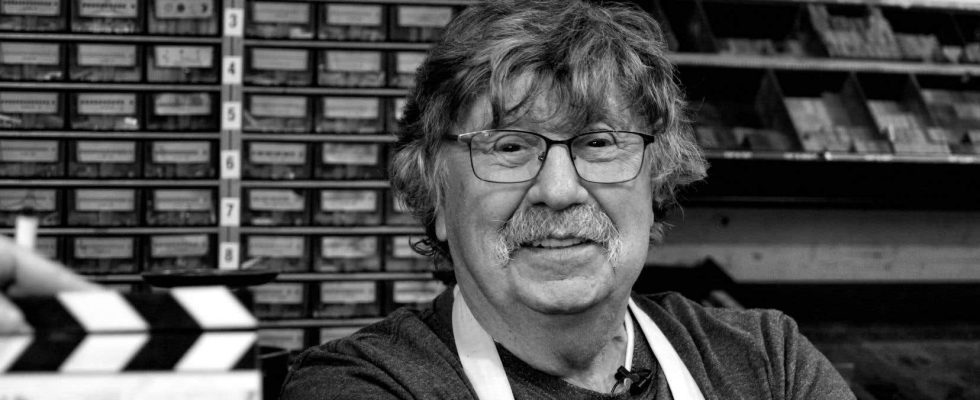Quantity of artists’ books, limited edition works, in poetry in particular, are due to his hands. Martin Dufour printed his favorite on his large Washington press, using fine papers. He was the expert in careful, numbered, limited and finally bound prints. How many artists’ books in Quebec are indebted, directly or indirectly, to his attentive care, to the expert hands of this patient typographer? Magician of old lead and wooden letters, master typographer Martin Dufour has died at the age of 87.
Gallerist Éric Devlin has supported several artists’ projects that Martin Dufour’s talent served. “Martin Dufour was our last great typographer,” he says. “And an absolutely lovely man.” »
“He was a great typographer, as well as an exceptional graphic designer, a master printer and a calligrapher,” says the publisher of Leméac, Pierre Filion, himself a typographic printer in his spare time. “A master of this value, for us, is exceptional. There was the typographer Glenn Goluska of almost the same level. Now there are only amateurs left next to guys like this. »
Round and generous in his speech, never stingy with his time, passionate about his profession as only a man can be forever excited by all the forms of life permitted by paper, Martin Dufour printed as he breathed. Printing was in particular what materialized his keen passion for poetry in particular and the arts in general.
A printing life
“All his life, Martin Dufour contributed to developing and producing the publications of others: writers, cartoonists, designers, painters, advertisers, exhibition curators,” wrote Bernard Lévy, from the magazine Life of the arts.
“He wrote so many books, for so many writers,” says Pierre Filion, who saw him for the last time last Friday. “One of his most important projects was the Ductus, in collaboration with his friend Jacques Brault. For art publishing, it is a landmark, enormous book, which impressed us greatly. He had put years of work into it. I think the copy of Ductus de Brault, Martin had put it back 10 or 15 years, I think, after having started it! Crazy work. » This “book” comes in the form of a portfolio, with engravings, several in color, with a slipcase signed by Pierre Ouvrard. Edition in 1984 of only 20 copies, numbered and signed by the poet Jacques Brault and the artist, Martin Dufour, to which are added eight non-commercial copies.
Dufour will have worked in close collaboration with several writers from here and elsewhere, to design non-commercial works prized by collectors. His characters gave an extra soul to the words that he knew how to weight with lead and wood to fix them as best as possible on the paper. He has accompanied the work of writers such as Gilles Hénault, Martine Audet, Michel van Schendel, Pierre Nepveu, Frédéric Jacques Temple, as well as that of renowned visual artists, such as René Derouin, John Grande, Francine Simonin, Louis-Pierre Bougie, Chantal Harvey and François-Xavier Marange. In all, he produced more than sixty artists’ books, these works that look like works of art, made by hand, in very small quantities.
“An artist’s book is a treasure that one consults alone in a quiet room in the house,” explained Martin Dufour in 2019. “Its appreciation requires an intimate and personal look, which is rarely shared. »
“He made spectacular books,” says gallery owner Éric Devlin. “We owe him Rosevi by Guido Molinari (1995), a very luxurious book. The work had cost a fortune to produce. We were selling it for $10,000 a book. The typography and layout were completely crazy, exceptional. »
Born on March 19, 1937, in Saint-Alexis de Matapédia, in Gaspésie, Martin Dufour designed, during his long life, a number of Quebec books in current editions. From 1971, several books from Éditions du Noroît are due to his steady hand.
“Martin’s life contains many detours since, in addition to books,” writes Bernard Lévy, “he created posters, leaflets, leaflets, labels for all kinds of products, packaging, commercial catalogs and catalogs of ‘art exhibition. You have to live well, right? »
Pierre Filion had commissioned him, until recently, to design the models for a collection from Editions Leméac. A collection dedicated to hosting the complete works of great writers, including Antonine Maillet and Jacques Poulin.
The bohemianism of the Washington press
“When he was young, he spent time in the army,” recalls Pierre Filion. “However, there was nothing military about it. Absolutely nothing ! He was more of an artist, always a bit bohemian. »
A student at the Montreal School of Fine Arts, Martin Dufour learned there, like the other students, to draw the letters of an alphabet. “I spent two years at the School of Fine Arts, before going to study at Sir George Williams, where we also learned that. » Arthur Gladu, the brother of the art critic Paul Gladu, keen on the Germanic tradition in printing, taught him typography, as he also did for the poet Roland Giguère.
Martin Dufour had taught graphic arts here and there, notably at the Cégep du Vieux Montréal. In his workshop, frequented by many young artists, he offered many introductions to working with lead.
Over time, he had gathered considerable documentation on the history of writing, typography and book production. He was particularly passionate about the origins of printing, with particular attention to the 16th century.e century. He revisited the rules of times gone by to give substance to new lives on paper, “in a contemporary approach,” he specified. In 2019, the Maison de la culture Claude-Léveillée dedicated an exhibition to his work.
Thick mustache, bushy hair eternally disheveled, this little round man that was Martin Dufour spoke of his Washington press of 1834, his favorite, with unfailing affection, as if it were, in truth, without anyone being able to doubt it for a moment , a living annex of his own arms, of his agile white fingers, forever stained with black ink.
